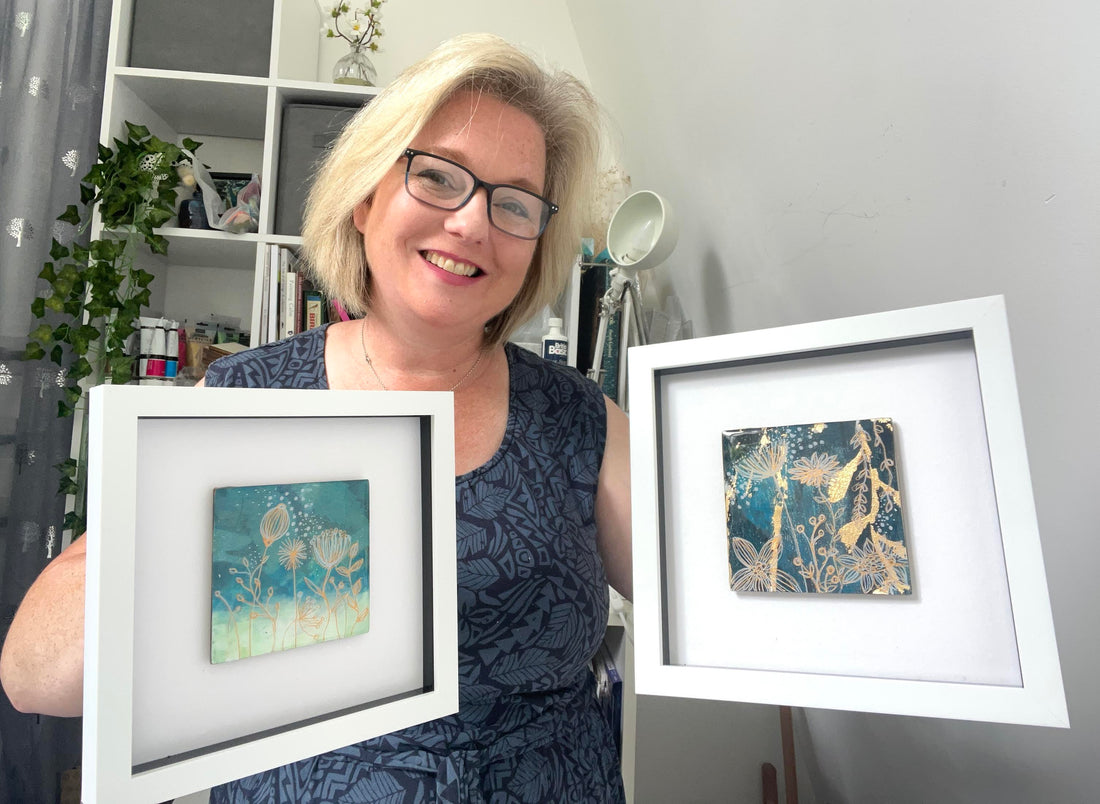Have you tried gel plate printing yet?
Gelli printing is a fun and easy way to create one-of-a-kind prints and collage papers. Using a soft gel pad, you roll on paint or ink—acrylic paint works best—then add leaves, flowers, stencils, or household objects to design your own custom prints.
Unlike lino or screen printing, gelli printing is simple, inexpensive, and requires minimal supplies. The process is easy to learn for beginners, while offering a fresh approach for more experienced printmakers. Gelli printing is surprisingly mess-free, and the gel plates are durable, easy to clean, and can be reused again and again.
The creative possibilities with gel printing are endless. Your prints can be used in collage work, framed as they are, or topped with a glossy resin coat to make the colors pop!
Artist Susan McCreevy, a gel printing expert based in Scotland, creates her own collage papers for mixed media art. She generously shares her knowledge through online courses, in-person workshops, YouTube tutorials, and social media posts.
In this blog, Susan will demonstrate how to apply ArtResin to a series of botanical-inspired gelli prints. Whether you’re just starting out or looking for new print-making and collage ideas, Susan’s tips and tricks will inspire your creativity!



What You’ll Need:
To Prepare The Gelli Prints:
- Gelli printing plate: see below for Susan's how-to video
- Paper of your choice: mixed media paper, copy paper, wet strength tissue paper
- Acrylic paint in your favorite color palette: Susan uses a lot of teals, blues, greens, and beiges in her work, as well as white and gold
- A brayer to spread the paint
- Objects to imprint: leaves and flowers work well
- Wooden artists' panel: either thin balsa or thicker birch panels work
- Spray or brush-on adhesive: to mount your print to the panel
- Gold or white paint markers to embellish your prints: see below for Susan's how-to video
- Spray fixative: to seal your print before you resin
To Resin The Gelli Prints:
- ArtResin
- Mixing container
- Stir stick
- Spreading tool
- Dust cover
- Painter's tape
- Maker's Studio Torch
Step 1: Prepare The Gelli Prints
Before you start, make sure to follow Susan's Gelli Print tutorial below, where she expertly guides you through the process of preparing your prints. Here's a quick overview of her approach:
She begins by rolling out a thin layer of paint on the gel plate using a brayer.

Next, Susan applies leaves or flowers to imprint.

She takes an initial print of the leaves.

Then removes them to capture a second imprint.


Susan repeats the pattern for a second imprint, this time using a darker paint color for contrast.

Using these techniques, Susan demonstrates how to create a variety of prints in her video, giving you a glimpse of what's possible for your own print making!





Susan then uses a clear-drying adhesive to mount her favorite sections onto wood panels.

For detailed instructions on creating your own Gelli Prints, please watch Susan's video.
Step 2: Embellish The Gelli Print
Though optional, Susan often adds hand-drawn elements to her Gelli prints. She especially enjoys the look of white, gold, and bronze embellishments.

Susan recommends using references to freehand a design onto your collage paper. She often draws inspiration from real leaves, flowers, or a book of botanical art.
Before committing to your final design, Susan suggests testing it on a scrap piece of the print. This helps refine your design and decide on the best ink color and line thickness.




Susan typically achieves the best results using fine or extra-fine paint pens and markers. Some of her favorites include:
- Posca acrylic paint markers in white, gold, and orange (0.7 mm and 2.5 mm)
- Uniball Signo UM-153 pens in white, gold, and bronze
- Sakura Pen-Touch gold marker
- Pentel White Hybrid Gel Grip Metallic pen (1 mm)
You can find links to the exact pens Susan uses in the caption of her YouTube video.
Step 3: Resin The Gelli Print
Now comes the fun part—adding a glossy topcoat of resin to your work!
First, seal the artwork with a clear-drying sealant. While you can use a brush-on sealant, it's a good idea to test it on a scrap piece first to make sure it won’t cause the ink or marker to smear.
For her pieces, Susan used a spray fixative by Winsor & Newton:

Once the sealant has dried as per the label instructions, you’re ready to apply the resin. Begin by gathering your tools and setting up a plastic-lined work surface.

Next, prepare the ArtResin.
If you’re unsure how much resin to use, enter the length and width of your panel into our Resin Calculator. For example, an 8 x 8" panel requires 2 oz of resin per 1/8" (3 mm) layer.
Multiply this amount by the number of panels you have to find the total amount of resin and hardener needed.

Wear gloves and measure equal volumes of resin and hardener into a graduated mixing cup. Stir well for 3 minutes, making sure to scrape the sides and bottom of the container for thorough blending.
💡 TIP: Since resin and hardener have different densities, the 1:1 ratio is accurate for volume but not for weight. If measuring by weight, use 100 parts resin to 84 parts hardener. This will ensure the correct 50/50 volume ratio and allow you to proceed with confidence!

Mount the panels off the work surface using plastic stands. Plastic shot glasses, like those Susan uses, work well for this purpose. Make sure the pieces are perfectly horizontal by using a bubble level.

Next, working one by one, pour a small amount of resin into the center of each piece and spread it to the edges with a plastic spreading tool.
💡 TIP: You can either spread the resin so it runs over the edges or gently nudge it up to the edge without going over. To catch drips, mask off the back with painter's tape. Remove the tape after 24 hours.


Next, quickly torch out any bubbles using a butane or propane torch.
💡 TIP: To avoid over-torching, keep the torch moving and avoid holding it too close or in one spot for too long. The flame should just touch the surface of the resin. Move the torch continuously, similar to ironing clothes, and make a quick pass or two to eliminate bubbles.

Inspect the piece for any final touch-ups, such as areas needing more resin, missed bubbles, or dust that needs to be removed with a toothpick. Once you’re satisfied with the result, cover the piece with a clean cardboard box (with the flaps cut out) to protect it.

After 24 hours, the resin should be dry to the touch. You can handle the panels at this point, but the resin will not be fully cured until the 72-hour mark.

Below, Susan compares one of her collage pieces without resin to a piece with a shiny resin topcoat. You can see how the resin enhances the piece, adding depth and dimension.

You can either leave the panels as they are or frame them. Susan used both a box frame and a floating frame—both options look fantastic!




Watch Susan's full video tutorial:
We hope you enjoyed this look into the creative world of Gelli Prints, and how to enhance your work with a shiny ArtResin topcoat!
Please leave any questions or comments below :)
To see more of Susan McCreevy's beautiful mixed media work:
Visit her website: www.susanmccreevy.com
Sign up for an online class: www.susanmccreevy.com/classes
Follow her on Instagram: @susanmccreevyartist
Like her Facebook page: @susanmccreevyartist
Watch her YouTube videos: www.susanmccreevy.com/youtube
ArtResin: The Original Epoxy For Resin Art.

